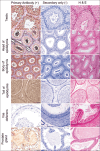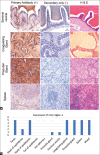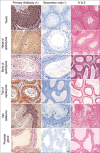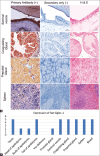Comparison of Siglec-1 protein networks and expression patterns in sperm and male reproductive tracts of mice, rats, and humans
- PMID: 38680147
- PMCID: PMC11045525
- DOI: 10.14202/vetworld.2024.645-657
Comparison of Siglec-1 protein networks and expression patterns in sperm and male reproductive tracts of mice, rats, and humans
Abstract
Background: Sialic acid-binding immunoglobulin-like lectin 1 (Siglec-1) is a transmembrane glycoprotein involved in the sialic acid (Sia)-dependent regulation of the immune system. Siglec-1 expression has recently been identified in the male reproductive tract (MRT) of several species, including humans, cattle, horses, and sheep, and may play a role in modulating fertility in a Sia-dependent manner.
Materials and methods: In this study, protein-protein interaction (PPI) analysis of Siglec-1 was conducted to identify associated network protein conservation, and the expression of Siglec-1 in the MRT of mice and rats, including their accessory sex glands and spermatozoa was determined by immunostaining.
Results: Network analysis of proteins with Siglec-1 in mice and rats demonstrated significant similarity to human Siglec-1 networks, suggesting a similar conservation of network proteins between these species and, hence, a potential conservation role in immune modulation and function. Specific immunostaining patterns of mouse and rat testes, epididymis, ductus deferens, accessory sex gland tissues, and sperm were detected using human Siglec-1. These results confirmed that the human Siglec-1 antibody could cross-react with mouse and rat Siglec-1, suggesting that the specific expression patterns of Siglec-1 in the MRT and sperm of both mice and rats are similar to those observed in other species.
Conclusions: The conservation of Siglec-1 expression patterns in sperm and within the MRT and the similarity of protein networks for Siglec-1 across species suggest that Siglec-1 may function in a similar manner across species. These results also suggest that rodents may serve as a valuable model system for exploring the function of Siglecs in the reproductive system across species and their potential role in modulating fertility in a Sia-dependent manner.
Keywords: female reproductive tract; male reproductive tract; protein–protein interaction; sialic acid; sialic acid-binding immunoglobulin-like lectin-1.
Copyright: © Almhanna, et al.
Conflict of interest statement
The authors declare that they have no competing interests.
Figures






Similar articles
-
Siglec expression on the surface of human, bull and ram sperm.Reproduction. 2018 Apr;155(4):361-371. doi: 10.1530/REP-17-0475. Reproduction. 2018. PMID: 29581386
-
Sialic Acid-Siglec-E Interactions During Pseudomonas aeruginosa Infection of Macrophages Interferes With Phagosome Maturation by Altering Intracellular Calcium Concentrations.Front Immunol. 2020 Feb 28;11:332. doi: 10.3389/fimmu.2020.00332. eCollection 2020. Front Immunol. 2020. PMID: 32184783 Free PMC article.
-
Sensing the neuronal glycocalyx by glial sialic acid binding immunoglobulin-like lectins.Neuroscience. 2014 Sep 5;275:113-24. doi: 10.1016/j.neuroscience.2014.05.061. Epub 2014 Jun 9. Neuroscience. 2014. PMID: 24924144 Review.
-
Lectin galactoside-binding soluble 3 binding protein (LGALS3BP) is a tumor-associated immunomodulatory ligand for CD33-related Siglecs.J Biol Chem. 2014 Nov 28;289(48):33481-91. doi: 10.1074/jbc.M114.593129. Epub 2014 Oct 15. J Biol Chem. 2014. PMID: 25320078 Free PMC article.
-
Siglecs in Brain Function and Neurological Disorders.Cells. 2019 Sep 22;8(10):1125. doi: 10.3390/cells8101125. Cells. 2019. PMID: 31546700 Free PMC article. Review.
Cited by
-
Pleiotropic Genes Affecting Milk Production, Fertility, and Health in Thai-Holstein Crossbred Dairy Cattle: A GWAS Approach.Animals (Basel). 2025 May 2;15(9):1320. doi: 10.3390/ani15091320. Animals (Basel). 2025. PMID: 40362136 Free PMC article.
References
-
- Warren L. The thiobarbituric acid assay of sialic acids. J. Biol. Chem. 1959;234(8):1971–1975. - PubMed
-
- Schröter S, Osterhoff C, McArdle W, Ivell R. The glycocalyx of the sperm surface. Hum. Reprod. Update. 1999;5(4):302–313. - PubMed
-
- Varki A, Schauer R. Essentials of Glycobiology. 2nd ed. United States: Cold Spring Harbor Laboratory Press; 2009. Sialic Acids. - PubMed
-
- Crocker P.R, Paulson J.C, Varki A. Siglecs and their roles in the immune system. Nat. Rev. Immunol. 2007;7(4):255–266. - PubMed
LinkOut - more resources
Full Text Sources
